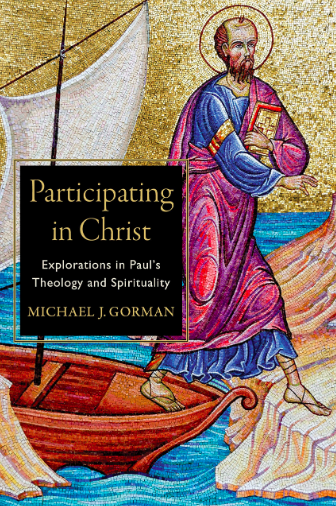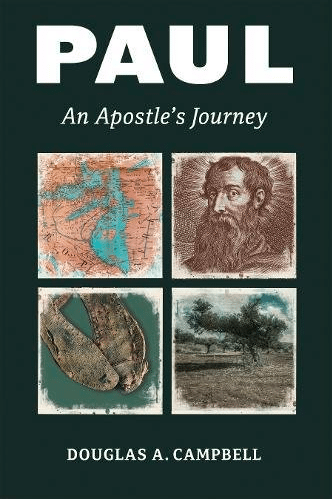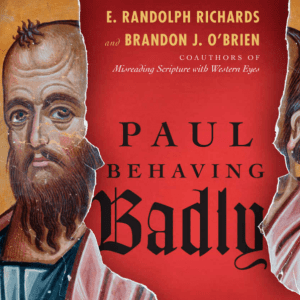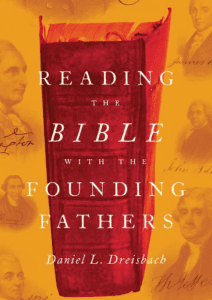 Peter Bouteneff, in the second chapter of his book Beginnings: Ancient Christian Readings of the Biblical Creation Narratives, discusses the uses of the creation narrative in the New Testament. The most important New Testament references are in the Pauline literature – which Bouteneff takes to include Ephesians, Colossians, and 2 Thessalonians, as well as the more commonly accepted Pauline canon, Romans, 1 and 2 Corinthians, Galatians, Philippians, 1 Thessalonians, and Philemon (more commonly accepted within within biblical scholarship that is). Bouteneff considers the Pastoral epistles separately.
Peter Bouteneff, in the second chapter of his book Beginnings: Ancient Christian Readings of the Biblical Creation Narratives, discusses the uses of the creation narrative in the New Testament. The most important New Testament references are in the Pauline literature – which Bouteneff takes to include Ephesians, Colossians, and 2 Thessalonians, as well as the more commonly accepted Pauline canon, Romans, 1 and 2 Corinthians, Galatians, Philippians, 1 Thessalonians, and Philemon (more commonly accepted within within biblical scholarship that is). Bouteneff considers the Pastoral epistles separately.
Paul was an educated Jew of his day and he uses the scriptures in a method entirely consistent with Second Temple Judaism – although his conclusions are distinctively Christian. Paul has been transformed and now reads the scriptures through the lens of his Damascus Road experience and the corporate experience of the early Christians. Bouteneff notes:
To Paul – the first Christian interpreter of the OT – the Scriptures speak of, anticipate, typologize, reveal, Christ, and him crucified. In effect, Paul takes the spectrum of Jewish hermeneutical methods – literal, allegorical, midrashic – and uses these instruments in a completely new way. In so doing, he says things that are revolutionary to the Jews, but in a language and framework very much their own. (p. 36)
First century Jews took scripture very seriously as revelation from God and the story of the mission of God in the world in and through Israel. However, they did not use scripture in the fashion common in 20th and 21st century evangelicalism. Examples of creative rereadings and appropriations of scripture abound in the pages of the New Testament. Out of Egypt I called my son is, for example, a creative appropriation of Hosea by Matthew as he sought to portray the depth of theological significance in the life, death, and resurrection of Jesus, God’s Messiah. Matthew was not bound by the authorial intent of Hosea. We’ve discussed the way Paul uses scripture in a number of posts, most recently Paul’s (First Century) Use of Scripture. Paul too was not bound by authorial intent – as his play with the word seed (Gal. 3) and creative use of Isaiah (Rom. 11) demonstrate.
One of the revolutionary developments in Paul deals with sin and redemption. It is suggested by some that a more traditional Jewish reading sees “sin as an act that can be repented of but Paul sees it as a condition from which we are freed and redeemed in Christ.” Paul uses the creation narratives to tell this Christ-centered story of redemption.
In Him All Things Hold Together. Bouteneff emphasizes that Paul’s use of the creation narratives in general and of Adam in particular is first and foremost Christ-centered. Paul did not start with a problem (sin) and look for a solution (Christ). He started with Christ and looked for ways to express the glory of the gospel of Christ in his day, age, and context. Col. 1:15-17, 1 Cor. 8:6 are key here – Christ is the image of the invisible God, the firstborn of all creation, all things have been created through Him, by Him, and for Him, in Him all things hold together, and we exist through Him. This theme is not limited to Paul, and is also seen in Hebrews 1:2 and John 1:3. This Christ-centered focus in Paul must be recalled when reading both Romans 5 and 1 Cor. 15.
For his starting point and focus are not finally sin (which is old news) but rather that which was new: Jesus Christ, Lord and Savior. Paul does nothing less than define the direction and the sequence, as it were, of Christian reflection on Christ. This direction is not the one commonly associated with Christianity, namely, a kind of chronological sequence from a perfect pre-fallen state, to a one-event calamitous fall, and then to salvation that comes in 33 CE. It is a sequence that begins with Christ himself: rather than Adam being a model or image for humanity or even the first human being, it is Christ who is both. Christ is the first true human being, and Christ is the image of God and the model for Adam. (p. 45)
When Paul focuses on Adam it is as an individual, but this is because he is developing a biblically based understanding of Christ. Adam is the primordial individual from whom all descend. He is the only suitable figure for describing the universal nature of redemption through Christ of Jew and Gentile alike. As man of dust he is the contrast to Christ, the life-giving spirit. But, for Paul, Adam was made for Christ – not Christ for Adam.
The universalizing impact of Paul’s use of Adam should not be minimized. The key passages in Romans and 1 Corinthians were most likely directed primarily toward Gentile Christians in Rome and Corinth. In discussing Romans 5 Bouteneff emphasizing this universal aspect of both sin and the redemption through Christ.
Making the first sinner and the first-made human being one and the same person has the effect of opening out the genealogy, the effects of sin, and therefore the scope of salvation, which now incorporates the Gentiles. The dividing line is no longer between Jew and Gentile, but between the old dispensation (or old Adam) and the new dispensation in Christ. (p. 40)
It seems clear that Paul’s view of the OT is centered in Christ. Adam is not the significant figure – Christ is the significant figure and the central figure in a Christian reading of history and a Christian reading of the Jewish scripture.
The Western church however has read Romans 5 with Adam responsible for original sin, corrupting the nature of all who follow. There are aspects of this reading that tend to make Adam the central figure. Christ is a response to Adam, not the central figure of history in whom all things have their being.
Bouteneff, coming from an Eastern Orthodox perspective, suggests that the traditional Western view of original sin is a distortion – “The idea of “original sin” as a causal factor lies not with Paul but with Jerome and, on the basis of Jerome’s translation, with Augustine.” (p. 41)
What matters to Paul is that Adam … sins and comes to stand for the one through whom sin – and therefore death – came into the world. … To see Adam as the original sinner was to establish him as the foil for Christ, the deliverer from sin and death. Christ could be seen as the new Adam. We know this story well but must recognize Paul’s genius in conceiving it. We must also know where to stop attributing theology to Paul: he did not say, for example, that all mortals sin “in Adam” or are born guilty of Adam’s sin. Nor, in fact, did he say anything about “pre-fallen” Adam or his immortality or perfection, for Adam was but “the man of dust.” Christ alone, for Paul, is the icon of God (Col. 1:15). (p. 54)
Paul’s use of Adam is significant because Adam universalizes the need for redemption back to the very beginning – not because Adam caused a problem in God’s perfect creation. Adam is the original sinner, not the origin of sin.
More from Colossians 1. As Bouteneff emphasizes, Paul sees Christ as having accomplished something of profound significance through his death and resurrection – he is the deliverer from sin and death. I started this discussion with the great Christological hymn Paul quotes in Col. 1:15-18. But in the focus on Col. 1:15-17 we can’t forget what comes in 19-23. We were alienated but have been reconciled. We have been freed and redeemed by God through Christ.
Regardless of where one comes down on the historicity of Adam, we ought to align ourselves with the Christ-centered focus of Paul. The linear sequence Creation-Fall-(Israel)-Redemption-(Church)-Consummation brings Christ into the middle of the story as a response to the first three acts. Adam’s act, according to this view, took things off course and requires Christ’s sacrifice as a corrective – a “plan B” to get us back on track. We need, perhaps, a more robust Christology and a view of the mission of God with Christ clearly at beginning in creation, at the center in reconciliation, and at the end in consummation.
How does our vision of creation mesh with a Christo-centric reading of scripture?
Is Christ a response to Adam?
If not, what impact does this have on our view of the mission of God?
If you wish to contact me directly you may do so at rjs4mail [at] att.net.
If interested you can subscribe to a full text feed of my posts at Musings on Science and Theology.











